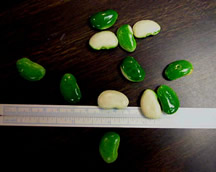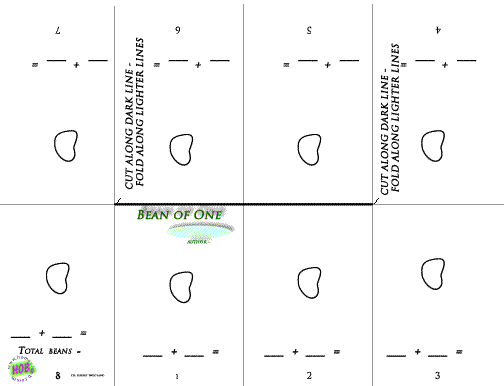 Bean Toss Games and
Bean Toss Games and
Bean Books
 Preparation: To make the beans get a package of dry Lima beans, a box or newspaper, and a spray can of enamel paint.
Preparation: To make the beans get a package of dry Lima beans, a box or newspaper, and a spray can of enamel paint.
Put the beans into a box or on a sheet of paper in a well ventilated area. Spread the beans out so they are separated and one side of each will be exposed to the spray. Lightly spray. It is best to spray a bit, stop, and check the results. It is easier to add more paint than deal with drips and blobs. Let them dry.
When the beans dry, they are ready for the students to toss.
Next select the number of beans students will toss and select the appropriate Bean Toss fold book from below.
Sample fold book pattern:

Fold books for different numbers of beans:
| one | two | three | four | five | six | seven | eight | nine | ten |
Practice making a book so you can teach students how to cut and fold their personal Bean Toss book.
Directions:
- Crease the paper along all the fold lines and then unfold the page.
- Fold the page in half perpendicular along the dark line in the pattern (hamburger fold). Then cut a slit along the dark cut line in the middle. See pattern.
- Open the page and fold along the longer line (hamburger fold), that you cut along.
- Now is the tricky part. Fold along the line between page 5 and 6 so that page 5 and 6 will be back to back. At the same time fold page 1 and 2 along the fold line so that they will be back to back. This will require bending the paper by opening a hole where the paper was cut. As you look down on the fold from the top, it will look like a + sign.
- When you finish that fold and bend, page 7 will be back to back with page 8 and page 3 will be back to back with page 4.
- Fold them to complete the book and all the pages will be in order.
Have students toss beans and record the results in their books.
When they have completed their books it is fun and interesting to record the class results. The data can be recorded on a chart and students can look for patterns and make predictive and probability statements.
Enjoy!